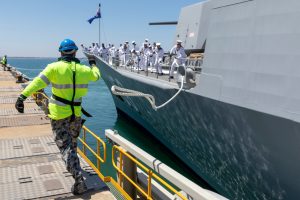Earlier this week the Australian Navy’s HMAS Toowoomba — an ANZAC-Class frigate — set sail from the Stirling naval base south of Perth in Western Australia for a six-month deployment in the Middle East. The vessel is set to join the United States-led International Maritime Security Construct (IMSC) that was created in September last year in response to Iranian seizures of commercial vessels in the Persian Gulf. The role of the IMSC is to boost freedom of navigation and anti-piracy operations in the Persian Gulf and Strait of Hormuz. The Australian Defence Force (ADF) will also be deploying the P-8A Poseidon maritime surveillance aircraft to assist with these operations, to be stationed in Bahrain.
Although the deployment is under the umbrella of the IMSC, it constitutes a rotation of Australia’s regular regional couterpriacy and counterterrorism involvement, Operation Manitou, which was initiated in July 2014 under the U.S-led 33-nation Combined Maritime Forces. The HMAS Toowoomba will replace the HMAS Ballarat, which was involved in a number of drug seizures during its deployment in the region that ended last July. Australia has maintained a naval presence in the region since 1990.
Australia’s decision to contribute to this new Middle East maritime operation can be understood from two positions. The first focused on direct material interests. The preservation of undisrupted shipping through the Strait of Hormuz is vital for safeguarding Australia’s oil supplies. It has become a considerable concern that Australia, at any given time, only has three weeks of petrol reserves in the country. As the prime minister noted in August when Australia’s participation in the IMSC was announced: “Fifteen to 16 percent of crude oil and 25 to 30 percent of refined oil destined for Australia transits through the Strait of Hormuz.” This makes maintaining secure lines of transport from these sources in the Middle East of vital strategic importance for Canberra.
The second position is rooted in the continued maintenance of the Australia’s alliance with the United States, which remains Canberra’s primary security asset. However, with regional tensions between the U.S. and Iran having been escalated, the Australian public would — rightly — be wary of Australia getting involved in another major U.S-led military engagement in the Middle East. Canberra will be hoping that Washington sees its killing of Iran’s Major General Soleimani as having sufficiently made its point, and Iran’s unintentional shooting down of Ukrainian Airlines Flight 752 leading Tehran to become contrite and restrained.
At a press conference for the August announcement of the deployment, Morrison stated that Australia’s involvement in the IMSC and the United States’ attempts to place significant pressure on Iran were two separate issues. He said that Australia’s action in the deployment would be bound to international maritime law, rather than American strategic posture. Yet Australia’s history of binding itself to American military action is a strong indicator of what future major engagements Canberra will participate in.
In a more indirect manner, Australia’s ongoing engagement in the Persian Gulf can also be seen as an essential component of Australia’s desire to be a two ocean power. This aspiration is driving its increased security cooperation with India, and explains why the country has enthusiastically adopted the “Indo-Pacific” label and concept. Australia’s long — and sparsely populated — Indian Ocean coast, as well as vast maritime jurisdiction, gives Canberra plenty of incentive to project power from its west, even though (oil and India aside) its interests are far more heavily invested in the Pacific, and it has indicated that it wishes to predominantly focus on this region.
Beyond this, Australia remains an active defender of the global commons, and would have been seriously concerned about Iran’s seizure of vessels in the Persian Gulf regardless of whether this directly affected its own direct interests. However, the deployment of the HMAS Toowoomba to the IMSC does highlight the problems with Australia’s interests in the region. Both its low level of fuel reserves that would seriously affect the country should this supply be significantly disrupted, and the bigger issue — although one with no current serious market-ready solution (although potential exists) — of a reliance on fossil fuels for its various energy and fuel generation. And that issue that is bound to be one that the Australian government will be unable to avoid forever.

































